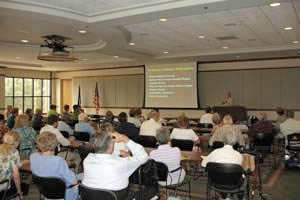|
 |
FAQs (Frequently Asked Questions)
Often we receive questions about different items and resources that may be of interest to our Parkinson's community.
If you have questions for our "FAQs" page, please Contact Us and we may include them on our list.
Why Do You Have The Red Tulip As Part Of Your Logo?
The tulip symbol, the "Dr. James Parkinson Tulip", has been adopted by many Parkinson's disease organizations and groups around the world. The story of the Parkinson tulip began in 1980 in the Netherlands when J.W.S. Van der Wereld, a Dutch horticulturist who had PD, gave the name "Dr. James Parkinson" to the red and white tulip he had developed.
In 1981, J.W.S. Van der Wereld registered his prize cultivar, the "Dr James Parkinson" bulb. The name was chosen to honor Dr. James Parkinson, the English doctor who described the condition in the 1817 "Essay On The Shaking Palsy", and to honor the International Year of the Disabled. |

Photo from
maltaparkinsons.com
|
On April 11, 2005, this red" Dr. James Parkinson Tulip" was launched as the Worldwide Symbol of Parkinson's Disease at the 9th World PD Day Conference in Luxembourg. The tulip 'Doctor James Parkinson' received the Award of Merit that same year from the Royal Horticultural Society in London England, and also received the Trial Garden Award from the Royal General Bulb Growers of Holland.
It is described as a flower: “exterior, glowing cardinal red, small feathered white edge, outer base whitish; inside, currant-red to turkey-red, broad feathered white edge, anthers pale yellow.” |
 Photo from Photo from
epda.eu.com |
 Photo from tulipworld.com Photo from tulipworld.com
|
Return to top of this page
Where can I find information about drugs - their interactions - identifying medications - FDA Drug Alerts - side effects - and more?
Drugs.com is the most popular, comprehensive and up-to-date source of drug information online. Providing free, peer-reviewed, accurate and independent advice on more than 24,000 prescription drugs, over-the-counter medicines & natural products. http://www.drugs.com/
|
Return to top of this page
Where can I search in one place for information about symptoms, treatments, doctors, and drugs?
Disclaimer: Healthline Networks is a "commercial advertising provider" of online health information for publishers, advertisers, and health insurance plans. Be advised that their search information
is not all inclusive -and- it definitely does not substitute for seeing your own personal doctors!
That having been said, their web site does provides useful search tools about health information.
The web page for Parkinson's disease has the following topics:
The other search tools available on this web site are:
|
Return to top of this page
| Why are there two different symbols for medicine? |
The rod of Asclepius ( also known as the asklepianis) is an ancient symbol associated with astrology, the Greek god Asclepius and with healing. It consists of a serpent entwined around a staff. The name of the symbol derives from its early and widespread association with Asclepius, the son of Apollo, who was a practitioner of medicine in ancient Greek mythology. His attributes of the snake and the staff, sometimes depicted separately in antiquity, are combined in this modern symbol.
For Reference Click Here |
Asclepius is the god of medicine and healing in ancient Greek religion. Asclepius represents the healing aspect of the medical arts; his daughters are Hygieia ("Health"), Iaso ("Medicine"), Aceso ("Healing"), Aglæa/Ægle ("Healthy Glow"), and Panacea ("Universal Remedy"). The rod of Asclepius, a snake-entwined staff, remains a symbol of medicine today, although sometimes the caduceus, or staff with two snakes, is mistakenly used instead.
For Reference Click Here |
Like the staff of Asclepius, the caduceus became associated with medicine through its use as a printer’s mark. Because printers saw themselves as messengers of the printed word and diffusers of knowledge (hence the choice of the winged symbol of the messenger of the ancient gods). A major reason for the current popularity of the caduceus as a medical symbol was its ill informed official adoption as the insignia for the Medical Department of the United States Army in 1902.
For Reference Click Here |
Return to top of this page
What is the Hippocratic Oath? ~and~ Why are there so many different versions of it?
The original text of the Hippocratic Oath is usually interpreted as one of the first statements of a moral of conduct to be used by physicians, assuming the respect for all human life, even unborn. It is widely believed to have been written by Hippocrates, the father of western medicine, in Ionic Greek (late 5th century BC), or by one of his students; and is usually included in the Hippocratic Corpus.
The Hippocratic Oath is an oath traditionally taken by doctors swearing to ethically practice medicine. Mostly of historical and traditional value, the oath is considered a rite of passage for practitioners of medicine in some countries, although nowadays the modernized version of the text varies among countries. Derivations of the oath have been modified over the years in various countries. In the USA, most Medicine schools administer some form of oath.
For Reference Click Here |
Return to top of this page
What do the Rx (prescription) abbreviations mean?
Prescription: A physician's order for the preparation and administration of a drug or device for a patient. A prescription has several parts. They include the superscription or heading with the symbol "R" or "Rx", which stands for the word recipe (meaning, in Latin, to take); the inscription, which contains the names and quantities of the ingredients; the subscription or directions for compounding the drug; and the signature which is often preceded by the sign "s" standing for signa (Latin for mark), giving the directions to be marked on the container.
Unless you have a medical background, that bunch of letters (abbreviations) on your prescription that your doctor may have written is probably unintelligible (no disrespect to our doctors - but we just don't know what they mean). If you'd like to find out what some of them mean, CLICK HERE ~~ for even more information CLICK HERE #2 ~~ and for even more information CLICK HERE #3
For medical terms and abbreviations commonly used in Adult Care Home Services and In-Home Service settings CLICK HERE |
Return to top of this page
What has smell got to do with Parkinson's?
People with a normal sense of smell can correctly identify around 35-40 smells. People with Parkinson's can identify 20 or less. In a recent article on the Northwest Parkinson's Foundation Jean Enersen discusses that a "Test might sniff out Parkinson's". Researchers like Kapil D. Sethi, MD, a neurologist at the Medical College of Georgia, want to know if a smell test (PARS) can identify healthy people who are at risk of developing Parkinson's. PARS = Parkinson Associated Risk Study ---- Click here to learn more about PARS
The PARS study is the largest study involving first-degree relatives of individuals diagnosed with Parkinson disease. The goal of the PARS study is to better understand who may be at risk for Parkinson disease so that it can ultimately be prevented before it starts. This study will evaluate thousands of individuals that have a relative affected by Parkinson disease to determine whether specific tests are able to predict who may be at increased risk for developing Parkinson disease. The initial test to be evaluated in the PARS study is a smell identification test that is distributed by mail and completed at home. By using smell testing in combination with other tests we hope to develop a system to detect signs or symptoms that may predict who is at risk for Parkinson disease.
To learn more about why the sense of smell may be an important screening tool for Parkinson disease go to What is the PARS study?
Clinical trial volunteers are needed! For more information about the PARS study and clinical trial being conducted by Kapil D. Sethi, MD, a neurologist at the Medical College of Georgia, please contact Sherry Banks at SBANKS@mail.mcg.edu or telephone 706-721-1238 |
Return to top of this page
Clinical Trials - Who? What? When? Where? Why? How?
A clinical trial (also clinical research) is a research study in human volunteers to answer specific health questions. Choosing to participate in a clinical trial is an important personal decision. This web page by the U.S. National Institutes of Health (NIH) has all the frequently asked questions and provides detailed information about clinical trials. In addition, the page provides very helpful information which enables you to talk to a physician, family members, or friends when trying to decide to join a clinical trial. After identifying some clinical trial options, this page provides information on how to contact the study research staff and ask questions about specific trials. Click here to go to the NIH "Understanding Clinical Trials" web page
ClinicalTrials.gov is a registry (list) of federally and privately supported clinical trials conducted in the United States and around the world. ClinicalTrials.gov gives you information about a trial's purpose, who may participate, locations, and phone numbers for more details.
Search for Clinical Trials - Find trials for a specific medical condition or other criteria in the ClinicalTrials.gov registry.
Investigator Instructions - Get instructions for clinical trial investigators/sponsors about how to register trials in ClinicalTrials.gov
Background Information - Learn about clinical trials and how to use ClinicalTrials.gov, or access other consumer health information from the US National Institutes of Health.
National Institute of Neurological Disorders and Stroke (NINDS) conducts and supports clinical research on brain and nervous system disorders. Created by the U.S. Congress in 1950, NINDS is one of the more than two dozen research institutes and centers that comprise the National Institutes of Health (NIH). The NIH, located in Bethesda, Maryland, is an agency of the Public Health Service within the U.S. Department of Health and Human Services. NINDS has occupied a central position in the world of neuroscience for 50 years. NINDS conducts several NIH Exploratory Trials in Parkinson's Disease (NET-PD).
Parkinson Study Group Clinical trials being conducted by the Parkinson Study Group and other groups within the United States are listed on this web site.
Parkinson's Disease Foundation PD Trials - Information about PD clinical trials in Parkinson's Disease are listed by all trials, location, trial type, symptoms, and keyword search. The PDtrials website provides information about current trials and about clinical trials being performed. This website also has current
clinical research news.
CenterWatch is a Boston-based publishing and information services company and a business of Jobson Medical Information, that provides clinical trial information services used by patients, pharmaceutical, biotechnology and medical device companies, CROs and research centers involved in clinical research around the world. |
Return to top of this page
Do you have: Information, Books / Publications, Videos, or Web Sites you would like to recommend? If so, please Contact Us and give us your recommendations, and we may include them on our website.
ODDS & ENDS - A place where we put anything that doesn't fit anywhere else on our website
BOOKS & PUBLICATIONS - What we are recommending for reading and where to find them
VIDEOS - What we are watching on the internet and where to find them
FAQS [Frequently Asked Questions] - Answers to some of the questions that people have sent us
|
|





